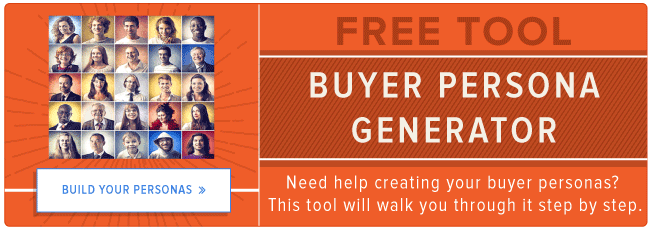Creating buyer personas is an essential part of building a successful inbound marketing strategy. Buyer personas help you better understand your current and potential customers, what their pain points are, what information they need, and how you can position your offering to meet their needs.
Without documented buyer personas, essential inbound marketing tasks such as creating engaging content can be challenging. And since creating engaging content is a top challenge for marketers, there is good reason to invest the time and resources into researching and developing your buyer personas.
When it comes to putting together buyer personas, there is no one correct way to do it. There are, however, some simple mistakes you can avoid making during the process. Below are some of the most common mistakes people make -- and how to avoid making them yourself.
1) Too many personas.
Creating too many personas can be really tempting. You might think you’re doing yourself and your team a favour by defining a bunch of personas, but having too many can be harmful. Chances are, with many personas, there won't be a clear delineation between them all -- making it really hard for you to actually attract, engage, convert, and delight any of them.
So start with one core persona and build up from there. Once you start to analyse the data based on your most successful customers, you will start to see where one persona ends and another begins. There should be clear differentiators between each persona -- the whole idea of creating personas is to create an experience that resonates with each of them. This will lead you to having a far clearer picture of the persona your marketing should be targeting.
Pro tip: Be ruthless when creating your personas. If you don't have enough information on a particular persona, remove it. In fact, don't be afraid to add or remove personas over time -- this guide will help you understand how and when you should do so.
2) Not thinking about negative personas.
There are people who you won’t want to target -- they may not have budget, they may be students, or they may be far too expensive to acquire as a customer. To identify and understand these kinds of people, you need to create a negative (or exclusionary) buyer person. It may appear counterproductive to spend timing getting to know people who will never be your customers, but, it will save you and your team time and money in the long run, as you will not waste time marketing and selling to these people.
Pro tip: One of the biggest challenges when creating buyer personas is knowing where to start your research. A great place to start for your negative personas is by interviewing a sample of customers who closed, but they had a very low average sale price. You could also speak with some customers with low customer satisfaction scores, which might be an indication they were never really a proper fit for your company. Our guide on creating negative personas will walk you through the whole process.
3) Thinking personas are only for Marketing.
This is one of the most common attitudes when creating personas. Creating personas is not one of those one-off exercises that your team does (and then promptly forgets about). Implement the persona across your entire funnel strategy and let everyone in the organisation know who they are dealing with, especially those in Sales and Services.
Pro tip: It's easy to see personas as something on a one-off item on your team's to-do list. If your entire company starts using your personas as soon as you have them created, you will develop good habits from the beginning. If you need inspiration on how to get started with them, we've put together this guide on ways to get use out of them.
4) Thinking personas are an individual person.
Personas are generalisations of your ideal clients -- they are not specific real people. Rather than identifying the challenges, goals, desires and needs of only one individual (such as Tom who works as a marketing executive in the printing shop down the road), aim to gather a collective of characterisations about your ideal customer.
This means, for example, that you can group multiple titles or job roles into one persona. At HubSpot, one of our primary personas is Marketing Mary, and we know that she typically is a Marketing Manager or a Director of Marketing. A real person can't be both -- but because Mary is a fictional representation, she could occupy either role.
Pro tip: A great place to start is by grouping your personas based on individual goals, as we do with Marketing Mary. Check out this great example of a buyer persona from Visual Creatives. Note how it includes all the roles and responsibilities an agency owner/founder might have. Going into such detail can really help your content creation and strategy, as you will know what your audience's everyday challenges are.

5) Describing an aspirational persona.
Instead of identifying the type of person or business you are currently making money from, a common mistake is to describe the person you dream of making money from. Try to stay grounded and realistic, and describe the person you are currently serving the needs of. It’s fine to have a persona created that describes the person you want to target in the future, but keep it at a high level until you feel like you have the resources to reposition yourself to be more attractive to your ideal audience.
Pro tip: Rather than relying on internal opinions and beliefs to guide your personas, allow your personas to be data-driven. Dig into your CRM, look for trends, and survey your current or past customers. This will mean your personas are more factual and current. Use tools such as Survey Monkey to help you gather the data. Not sure what questions to ask? This guide will steer you in the right direction.
6) Basing your personas on old-school demographics.
Sure, demographic information is important to include, but it’s not the information that should differentiate your personas. Psychographic information is what makes your personas so powerful.
So, rather than defining your personas like “male, 30-45 years old, urban, mid-salary role,” think more about what the persona does, how their day looks, how they consume media, what challenges they face, and how they measure success -- and define your personas around this information. Allow this to define how and when you interact with your audience -- if it’s a mid-level business person based in London, for example, you may want to post mobile-friendly content between the hours of 7 and 8 a.m. local time for their morning commute.
Pro tip: Prioritise understanding what your persona's typical day looks likes, and use that as the core of your document. Referring back to our example from Visual Creatives above, you can see how they've broken down the "Story" part of their persona, which accurately profiles persona challenges, desires, and daily life.

7) Not knowing how to research your personas.
Not knowing how to practically research personas can be a barrier to creating buyer personas for many marketers. Many start with jotting down what they think their buyer personas should be, or relying on anecdotal input from their team. This results in a very one-sided view of a company's buyer personas, and it might not be that realistic.
Pro tip: Thoroughly researching your buyer personas should include everything from speaking to your sales team to speaking with your current customers (long-term and new) to researching current marketing trends to diving into your analytics. You can also develop and add to your personas as time goes on -- they don't need to be "complete" from day one.
8) Thinking persona development is difficult.
Some people think persona development is a massive job, and they don’t see the benefit in investing time into creating them. At the end of the day, persona development really doesn’t take that long. You don’t need to go into great detail when you are starting off, and remember you can add to them later if you like.
As for not seeing the benefit in the time investment, remember that your personas are going to be a massive help to your content creation, SEO, and social media strategy. It will save you time in the long-run and ensure that you attract the right people to your business, helping you grow much faster and better than you would have otherwise.
Pro tip: Whether you're just getting started with personas or if you've already begun your research, try out our free new persona generator here. It will help you focus, simplify and streamline your persona development.
Buyer Personas




![The definition of a buyer persona [in under 100 words]](https://53.fs1.hubspotusercontent-na1.net/hubfs/53/Copy%20of%20Featured%20Image%20Template%20Backgrounds.webp)

![How to Create Detailed Buyer Personas for Your Business [+ Free Persona Template]](https://53.fs1.hubspotusercontent-na1.net/hubfs/53/buyer-persona-research_1.webp)





